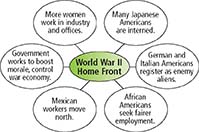CHAPTER 24: Quick Study Guide
Progress Monitoring Online
For: Self-test with vocabulary practice
Web Code: nea-1112
- Allied Leaders, World War II
World Political U.S. Military - Winston Churchill, Britain
- Joseph Stalin, Soviet Union
- Franklin D. Roosevelt, United States
- Harry S. Truman, United States
In Europe
- Dwight Eisenhower
- George S. Patton
- Omar Bradley
In the Pacific
- Douglas MacArthur
- Chester Nimitz
- World War II Home Front
- Five Turning Points of World War II
1942 Battle of Midway halts Japanese expansion in Pacific. 1942–1943 Battle of Stalingrad ends Nazi advances in Europe. 1942 Battle of El Alamein begins Allied offensive against Axis Powers in North Africa. 1944 D-Day invasion opens second front in Europe, paving way for final defeat of Germany. 1945 Manhattan Project develops atomic bomb, used to end war in Pacific. - World War II Deaths, Selected Nations
Country Military Deaths Civilian Deaths SOURCES: Henri Michel, Encyclopaedia Britannica; Harper Encyclopedia of Military History All figures are estimates. Axis Germany 3,500,000 780,000 Italy 242,000 153,000 Japan 1,300,000 672,000 Allies France 213,000 350,000 Britain 264,000 93,000 China 1,310,000 1,000,000 Soviet Union 7,500,000 15,000,000 United States 292,000 6,000
 Quick Study Timeline
Quick Study Timeline
For: Interactive timeline
Web Code: nep-1114






